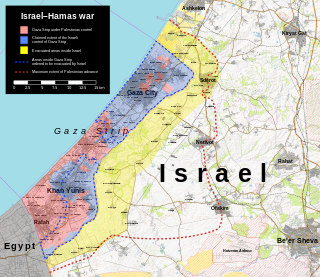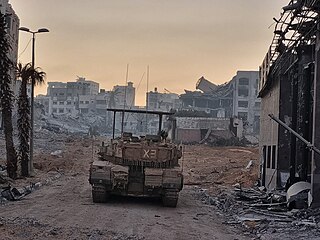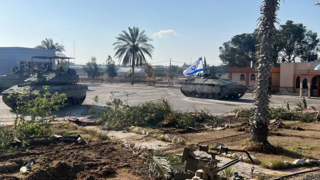
Jabalia, also spelled Jabalya, is a city in the State of Palestine located 4 kilometers (2.5 mi) north of Gaza City, in the North Gaza Governorate of the Gaza Strip. According to the Palestinian Central Bureau of Statistics, Jabalia had a population of 172,704 in 2017. The Jabalia refugee camp is adjacent to the city to the north. The nearby town of Nazla is a part of the Jabalia municipality.

Al-Qassam Brigades, also known as the Izz al-Din al-Qassam Brigades, named after Izz ad-Din al-Qassam, is the military wing of the Palestinian nationalist Sunni Islamist organization Hamas. Led by Mohammed Deif until his presumed death on 13 July 2024, the Al-Qassam Brigades is the largest and best-equipped militia operating within the Gaza Strip in recent years.

Al-Quds Brigades is a paramilitary organisation and the armed wing of the Palestinian Islamist organization Palestinian Islamic Jihad (PIJ), which is the second largest armed group in the Gaza Strip, after Hamas. AQB's leader is Ziyad al-Nakhalah, based in Damascus, Syria. The head of AQB in the Gaza Strip was Baha Abu al-Ata until he was killed in November 2019.

Netzarim was an Israeli settlement in the Gaza Strip about 5 kilometers southwest of Gaza City. It was established in 1972. In August 2005, the inhabitants of Netzarim were evicted by the Israel Defense Forces (IDF) as part of Israel's unilateral disengagement plan.

The Gaza–Israel conflict is a localized part of the Israeli–Palestinian conflict beginning in 1948, when about 200,000 of the more than 700,000 Palestinians who fled or were expelled from their homes settled in the Gaza Strip as refugees. Since then, Israel has been involved in about 15 wars involving organizations in the Gaza Strip. The number of Palestinians killed in the ongoing 2023–2024 war (41,000) is higher than the death toll of all other wars in the Israeli-Palestinian conflict combined.
Juhor ad-Dik is a Palestinian farming village in the Gaza Governorate, south of Gaza City, in the central Gaza Strip. According to the Palestinian Central Bureau of Statistics (PCBS), the village had a population of 4,586 inhabitants in 2017. This area is controlled by Israel due to the Israel–Hamas war. In May, 2024, the Washington Post reported that the village had been destroyed in order to construct the Netzarim Corridor.
The year 2023 in Israel was defined first by wide-scale protests against a proposed judicial reform, and then by the Hamas-led attack on Israel on October 7, which led to a war and to Israel invading the Gaza Strip.

The Israeli invasion of the Gaza Strip is a major part of the Israel–Hamas war. Starting on 7 October 2023, immediately after the Hamas-led attacks on Israel, it began bombing the Gaza Strip; on 13 October, Israel began ground operations in Gaza, and on 27 October, a full-scale invasion was launched. Israel's campaign has four stated goals: to destroy Hamas, to free the hostages, to ensure Gaza no longer poses a threat to Israel, and to return displaced residents of Northern Israel. More than 35,000 Palestinians have been killed in Gaza since the Israeli operation began, including more than 7,800 children and 4,900 women, with another 10,000 people missing and presumed dead under the rubble of destroyed buildings.
Since October 2023, multiple attacks during the Israel–Hamas war hit Palestinians attempting to leave northern Gaza City. On 13 October, an airstrike occurred after an evacuation directive from Israel, urging more than a million residents from northern Gaza to move to the southern part of the territory. The airstrike killed 70 people, mostly women and children, and injured 200.

The battle of Beit Hanoun began on 27 October 2023 in the midst of the 2023 Israeli invasion of the Gaza Strip. On 18 December 2023, Israeli forces had prematurely signalled that they had full control over Beit Hanoun and had destroyed Hamas’ Beit Hanoun Battalion. However, clashes continued in the town. Israeli forces withdrew from the town on the 24th of December. Subsequently, some Palestinian militants infiltrated back into the town and conducted attacks against Israeli forces to the east.
The siege of Gaza City began on 2 November 2023, when the Israel Defense Forces (IDF) surrounded Gaza City, amid the Israeli invasion of the Gaza Strip, which was a counterattack to the 2023 Hamas-led attack on Israel. Gaza City is the most populated city in the Gaza Strip and the battle started on 30 October 2023, when Israel and Hamas clashed in Gaza City. According to Oxfam, there are about 500,000 Palestinians, along with 200 Israelis and other captives, were trapped in a "siege within a siege" in northern Gaza.

The battle of Khan Yunis, which evolved into the siege of Khan Yunis in late January 2024, began on 1 December 2023 in the midst of the Israeli invasion of the Gaza Strip.

On 6 May 2024, Israel began a military offensive in and around the city of Rafah as part of its invasion of the Gaza Strip during the Israel–Hamas war.

The Netzarim Corridor is a zone of occupation that Israel has set up in the Gaza Strip during the ongoing Israel-Hamas war. The corridor, which splits the Gaza Strip down the middle, is located just south of Gaza City and stretches from the Gaza-Israel border to the Mediterranean Sea. The corridor is named for the site of the former Israeli settlement that it includes.

The siege of Al-Qarara was a military engagement between invading Israeli forces and local Palestinian forces.
The second battle of Khan Yunis was a military engagement in the Gaza Strip that began on 22 July 2024 as part of the ongoing Israel–Hamas war. It marked the return of the Israel Defense Forces (IDF) to the Khan Yunis area inside the Gaza Strip after a previous battle and siege which lasted from December 2023 to April 2024 and ended with an Israeli withdrawal.
The third battle of Khan Yunis was a battle in the Israel-Hamas war which began on 9 August 2024. The battle represented the third separate ground operation in Khan Yunis by Israel against Hamas-led Palestinian forces, following the first siege and a brief second battle in the city. Like the previous two battles, it ended in an Israeli withdrawal from Khan Yunis.

The siege of North Gaza is an ongoing engagement of the Israel–Hamas war in the North Gaza Governorate, Gaza Strip, between Israel and Hamas-led Palestinian forces. It began on 5 October 2024 when the Israel Defense Forces (IDF) reinvaded Jabalia and its refugee camp for the first time in months since earlier fighting.








